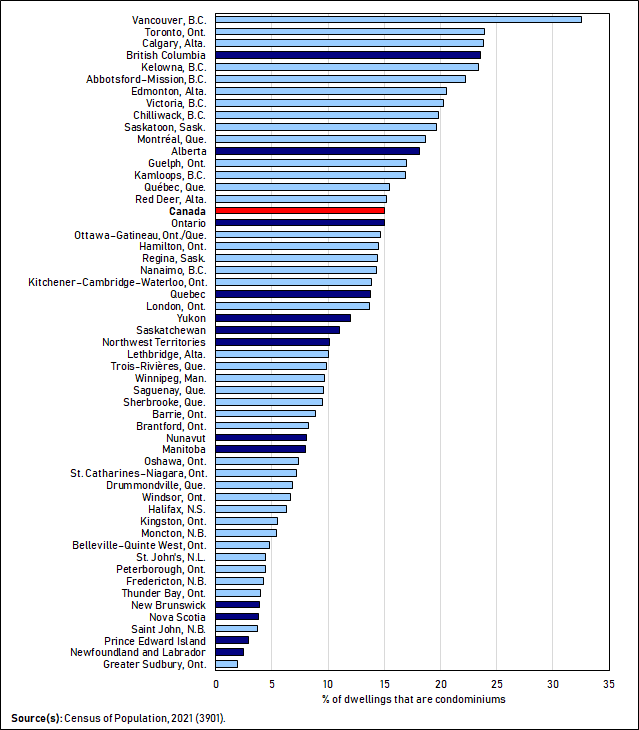Infographic 2
The majority of condominiums in Canada in 2021 are in census metropolitan areas

Infographic description
The title of the infographic is "The majority of condominiums in Canada in 2021 are in census metropolitan areas"
This is a horizontal bar chart showing the percentage of occupied dwellings that are condominiums in Canada, the provinces and territories, and census metropolitan areas.
The horizontal axis shows the percentage of occupied dwellings that are condominiums from 0.0 to 35.0, in intervals of 5.0.
The vertical axis shows Canada, the provinces and territories, and census metropolitan areas.
In Vancouver, British Columbia, the percentage of occupied dwellings that were condominiums in 2021 was 32.5%.
In Toronto, Ontario, the percentage of occupied dwellings that were condominiums in 2021 was 23.9%.
In Calgary, Alberta, the percentage of occupied dwellings that were condominiums in 2021 was 23.8%.
In British Columbia, the percentage of occupied dwellings that were condominiums in 2021 was 23.6%.
In Kelowna, British Columbia, the percentage of occupied dwellings that were condominiums in 2021 was 23.4%.
In Abbotsford–Mission, British Columbia, the percentage of occupied dwellings that were condominiums in 2021 was 22.2%.
In Edmonton, Alberta, the percentage of occupied dwellings that were condominiums in 2021 was 20.5%.
In Victoria, British Columbia, the percentage of occupied dwellings that were condominiums in 2021 was 20.3%.
In Chilliwack, British Columbia, the percentage of occupied dwellings that were condominiums in 2021 was 19.8%.
In Saskatoon, Saskatchewan, the percentage of occupied dwellings that were condominiums in 2021 was 19.6%.
In Montréal, Quebec, the percentage of occupied dwellings that were condominiums in 2021 was 18.7%.
In Alberta, the percentage of occupied dwellings that were condominiums in 2021 was 18.1%.
In Guelph, Ontario, the percentage of occupied dwellings that were condominiums in 2021 was 17.0%.
In Kamloops, British Columbia, the percentage of occupied dwellings that were condominiums in 2021 was 16.9%.
In Québec, Quebec, the percentage of occupied dwellings that were condominiums in 2021 was 15.5%.
In Red Deer, Alberta, the percentage of occupied dwellings that were condominiums in 2021 was 15.2%.
In Canada, the percentage of occupied dwellings that were condominiums in 2021 was 15.0%.
In Ontario, the percentage of occupied dwellings that were condominiums in 2021 was 15.0%.
In Ottawa–Gatineau, Ontario/Quebec, the percentage of occupied dwellings that were condominiums in 2021 was 14.7%.
In Hamilton, Ontario, the percentage of occupied dwellings that were condominiums in 2021 was 14.5%.
In Regina, Saskatchewan, the percentage of occupied dwellings that were condominiums in 2021 was 14.4%.
In Nanaimo, British Columbia, the percentage of occupied dwellings that were condominiums in 2021 was 14.3%.
In Kitchener–Cambridge–Waterloo, Ontario, the percentage of occupied dwellings that were condominiums in 2021 was 13.9%.
In Quebec, the percentage of occupied dwellings that were condominiums in 2021 was 13.8%.
In London, Ontario, the percentage of occupied dwellings that were condominiums in 2021 was 13.7%.
In the Yukon, the percentage of occupied dwellings that were condominiums in 2021 was 12.0%.
In Saskatchewan, the percentage of occupied dwellings that were condominiums in 2021 was 11.0%.
In the Northwest Territories, the percentage of occupied dwellings that were condominiums in 2021 was 10.1%.
In Lethbridge, Alberta, the percentage of occupied dwellings that were condominiums in 2021 was 10.0%.
In Trois-Rivières, Quebec, the percentage of occupied dwellings that were condominiums in 2021 was 9.9%.
In Winnipeg, Manitoba, the percentage of occupied dwellings that were condominiums in 2021 was 9.7%.
In Saguenay, Quebec, the percentage of occupied dwellings that were condominiums in 2021 was 9.6%.
In Sherbrooke, Quebec, the percentage of occupied dwellings that were condominiums in 2021 was 9.5%.
In Barrie, Ontario, the percentage of occupied dwellings that were condominiums in 2021 was 8.9%.
In Brantford, Ontario, the percentage of occupied dwellings that were condominiums in 2021 was 8.3%.
In Nunavut, the percentage of occupied dwellings that were condominiums in 2021 was 8.1%.
In Manitoba, the percentage of occupied dwellings that were condominiums in 2021 was 8.0%.
In Oshawa, Ontario, the percentage of occupied dwellings that were condominiums in 2021 was 7.4%.
In St. Catharines–Niagara, Ontario, the percentage of occupied dwellings that were condominiums in 2021 was 7.2%.
In Drummondville, Quebec, the percentage of occupied dwellings that were condominiums in 2021 was 6.8%.
In Windsor, Ontario, the percentage of occupied dwellings that were condominiums in 2021 was 6.7%.
In Halifax, Nova Scotia, the percentage of occupied dwellings that were condominiums in 2021 was 6.3%.
In Kingston, Ontario, the percentage of occupied dwellings that were condominiums in 2021 was 5.5%.
In Moncton, New Brunswick, the percentage of occupied dwellings that were condominiums in 2021 was 5.4%.
In Belleville–Quinte West, Ontario, the percentage of occupied dwellings that were condominiums in 2021 was 4.8%.
In St. John's, Newfoundland and Labrador, the percentage of occupied dwellings that were condominiums in 2021 was 4.4%.
In Peterborough, Ontario, the percentage of occupied dwellings that were condominiums in 2021 was 4.4%.
In Fredericton, New Brunswick, the percentage of occupied dwellings that were condominiums in 2021 was 4.3%.
In Thunder Bay, Ontario, the percentage of occupied dwellings that were condominiums in 2021 was 4.0%.
In New Brunswick, the percentage of occupied dwellings that were condominiums in 2021 was 3.9%.
In Nova Scotia, the percentage of occupied dwellings that were condominiums in 2021 was 3.8%.
In Saint John, New Brunswick, the percentage of occupied dwellings that were condominiums in 2021 was 3.7%.
In Prince Edward Island, the percentage of occupied dwellings that were condominiums in 2021 was 2.9%.
In Newfoundland and Labrador, the percentage of occupied dwellings that were condominiums in 2021 was 2.5%.
In Greater Sudbury, Ontario, the percentage of occupied dwellings that were condominiums in 2021 was 1.9%.
Source(s): Census of Population, 2021 (3901).
- Date modified: